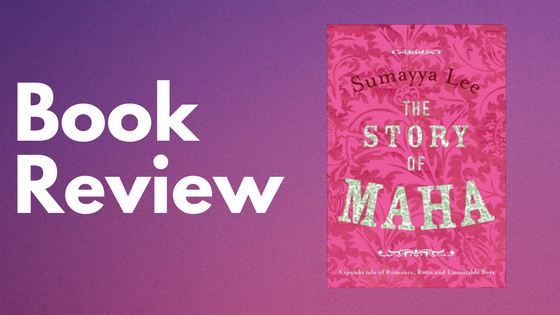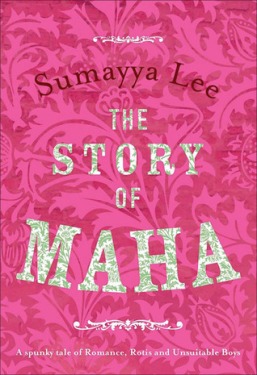
I received a free e-copy of this book in exchange for an open and honest review.
When I first started blogging about books, I had a small understanding of what diverse literature and stories were. I thought mostly about diverse authors from the United States and less about global perspectives. I also failed to acknowledge the many intersections of identities that were missing from published literature. As I continue to grow in this journey as a book blogger, I am discovering and learning about more #OwnVoices books. One of these books is The Story of Maha by Sumayya Lee. This beautifully written coming of age story follows Maha, a South African Indian Muslim girl during Apartheid in South Africa, from her childhood through her teenage years. After Maha’s parents are killed tragically in a political rally, she is relocated from Cape Town to the suburbs to live with her extended family.
For me, the story started off very slow and I found myself having a difficult time getting in the flow and the story. However, as I progressed through the different experiences of Maha growing up, I became more engrossed and more attached to Maha as a character. It was similar to getting to know a good friend slowly over time and I think the author deserves a lot of credit for not only writing style but how Sumayya Lee constructed the story to build off experiences. The story deals with tragedy and love and loss and growing up and rebellion. Against a background of angst and struggle are charming vignettes of how Maha navigates her new environment in the suburbs, and how Maha navigates her culture, religion, and her grandparents. The stories range from heartbreaking to hilarious. Maha is such a dynamic person and character – I loved each and every struggle and adventure.
 The Story of Maha is chalk full of culture and language, which makes the book very immersive for the reader, regardless of they background. The use of Gujarati is peppered throughout and the story does not pause to explain or translate for the reader. This in my opinion is a good thing. The conversations and thought process of Maha is natural because of the writing and the use of language. In some instances, the reader is learning slang along with Maha, but the intention of the language is not to educate readers outside of this culture. As a reader, I found enough context clues to understand what was going on and the feelings in the different scenes.
The Story of Maha is chalk full of culture and language, which makes the book very immersive for the reader, regardless of they background. The use of Gujarati is peppered throughout and the story does not pause to explain or translate for the reader. This in my opinion is a good thing. The conversations and thought process of Maha is natural because of the writing and the use of language. In some instances, the reader is learning slang along with Maha, but the intention of the language is not to educate readers outside of this culture. As a reader, I found enough context clues to understand what was going on and the feelings in the different scenes.
The Story of Maha addresses pretty large concepts such as colorism, gender roles, and classism in the Indo South African Muslim community. From the moment the book talks about Maha’s parents, the issue of skin color and hair texture becomes a common refrain among Maha’s grandparents. While Maha is learning to accept herself and becoming proud of how she looks, she experiences the effects of Apartheid in South Africa, which leads her to explore more about her parents and their activism. These views continue as Maha grows older and the inevitable search for a Marriage to a Suitable Boy by her grandparents ensues. The choice for a suitable partner has a lot to do with family name, family origin, wealth, and race. These moments happen within a culture context, one that is not shared in mainstream literature often and one that is stereotyped and portrayed negatively. Whether you agree or disagree, whether this is similar to your experience or different, there is validity, authenticity, and truth in Maha’s experience.
The incorporation of Islam and spiritual beliefs was done in a very positive way. While Maha often butts up against her religious traditions, she also had a positive incorporation of her beliefs and traditions in her daily life. A lot of the topics discussed in conversation between Maha and her friends / role models seemed normal for teenagers to explore; however, they tend to fall outside of the conservative values presented in the culture. Through a western lens, we often interpret this as bad. While there may be issues to talk about or resolve, this is not how we should be viewing these stories. The incorporation of religion in the story is an essential part of Maha’s life experience and allows the author to tell a very personal story of how a teenager navigates and makes meaning within this context.
Wow! I did not know what to expect when I received this book. All I knew was a brief one line description. And this book does not disappoint. The Story of Maha hits everything I am looking for in a coming of age book – steeped in culture and traditions, positive representation of diverse people, struggles of a teen, times of hardship and times of joy, subtle humor that warms the heart, and outright rebellion against the rules. I would highly recommend adding this book to you “to-read” list and starting it right away. Sumayya Lee has written a unique gem from an #OwnVoices perspective.
Final Rating 4.7/5

I am glad you really enjoyed the read. It sounds like a well written book. It is nice to see that Maha’s character was extremely well developed
LikeLiked by 1 person
Posted by Resh Susan @ The Book Satchel | December 8, 2016, 5:19 AMYes, the character development was great! Thank you for stopping by 🙂
LikeLike
Posted by Brendon | December 9, 2016, 6:25 PMThis sounds fascinating. The use of Gujarati is interesting. It’s good there are enough clues from the context for non-speakers to understand what the words mean.
LikeLiked by 1 person
Posted by A.M.B. | December 8, 2016, 9:56 AMYes, I like when books can use different languages without having to directly translate the words. I gives a better flow in my opinion and stays more true culturally.
LikeLike
Posted by Brendon | December 9, 2016, 6:26 PMWonderful review. That’s one of the elements of being a diverse book reader that I love, the introduction to a whole new world of literature full of culture, diversity, and knowledge. It’s definitely helped me evolve as a reader and as an individual. 🙂 I liked reading your thoughts on the title. It sounds absolutely wonderful, albeit emotional. I will have to pick up a copy and check it out. Thank you for sharing this.
LikeLiked by 1 person
Posted by biblionyan | December 8, 2016, 10:56 AMThank you for stopping by and commenting! I love that aspect too! Literature is a fantastic medium to share and hear stories and experience. I hope you have a chance to read The Story of Maha.
LikeLiked by 1 person
Posted by Brendon | December 13, 2016, 1:36 PMBrendon, you write the most thoughtful reviews! It sounds like character development really drives this story, but in a more deliberate way. I love that concept. Character development is key to my enjoyment of any novel.
I haven’t heard of this book before. I’m so glad you reviewed it!
LikeLiked by 1 person
Posted by Jackie B @ Death by Tsundoku | December 8, 2016, 5:03 PMThank you 🙂 your comments mean a lot to me! Yes, I think the progression of character development really made the experiences of Maha shine. Like I said in my review, it was like getting to know a close friend -> Maha’s quirks and personality developed as she grew up.
LikeLiked by 1 person
Posted by Brendon | December 13, 2016, 1:37 PMI agree with Jackie! You write some of the most thoughtful reviews and I love reading them. 🙂
This is the first review I’ve read for The Story of Maha and you’ve certainly convinced me to bump it up on my TBR! There are a myriad intersections of identity, culture, religion, and marginalizations that I’ve yet to explore. What strikes me about The Story of Maha is the intersection of South African culture, Indian heritage and Islam. Wow, This is the only book I’ve heard about that deals with such an experience. That’s not a book you see published in the U.S., so you’re very right about the importance of reading in a more global sense.
Glad you enjoyed the book!
LikeLiked by 2 people
Posted by Read Diverse Books | December 10, 2016, 4:57 PMThank you 🙂 you all are so flattering… When I first heard the description of the book, I had a similar reaction: Wow! All those intersections of identity. I bumped it up and I am so glad I did. I hope this book gets more buzz because it definitely deserves it.
LikeLike
Posted by Brendon | December 13, 2016, 1:45 PMYour review is AMAZING and well thought out. Love it. Glad you enjoyed the book and learning about South African Indian culture! =)
LikeLiked by 1 person
Posted by juwithemad | December 21, 2016, 6:28 AMThank you 🙂 I am very happy I got the opportunity to read and write about this fantastic book!
LikeLike
Posted by Brendon | December 21, 2016, 10:27 AMColorism is such an important issue in many cultures and I’m glad it’s tackled in this book too. Will keep an eye out for it.
LikeLike
Posted by Glaiza | December 23, 2016, 7:19 AM